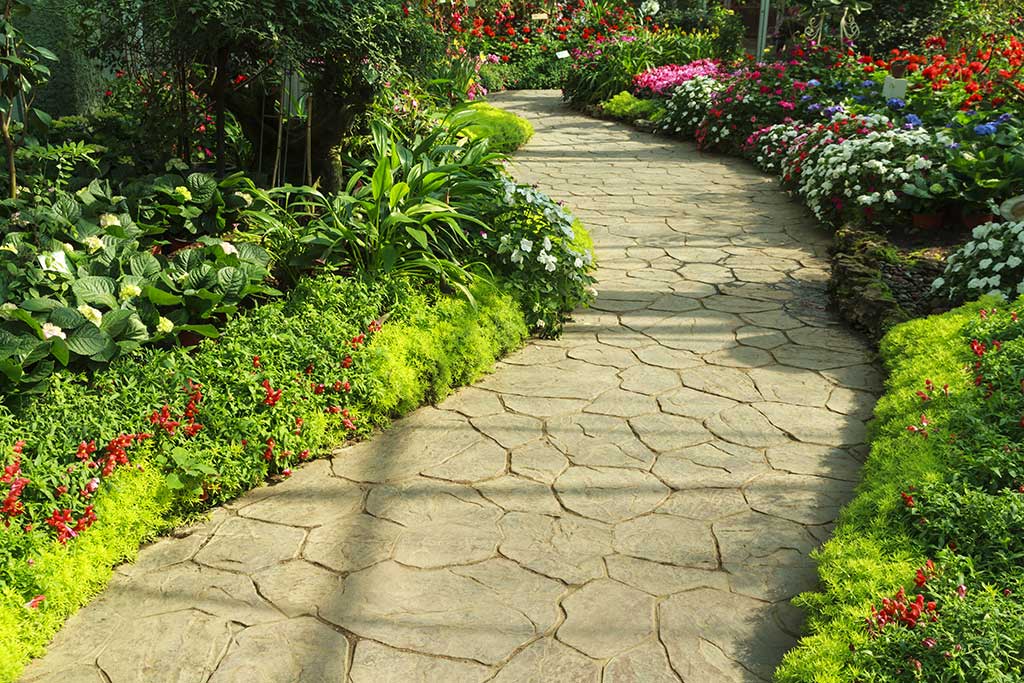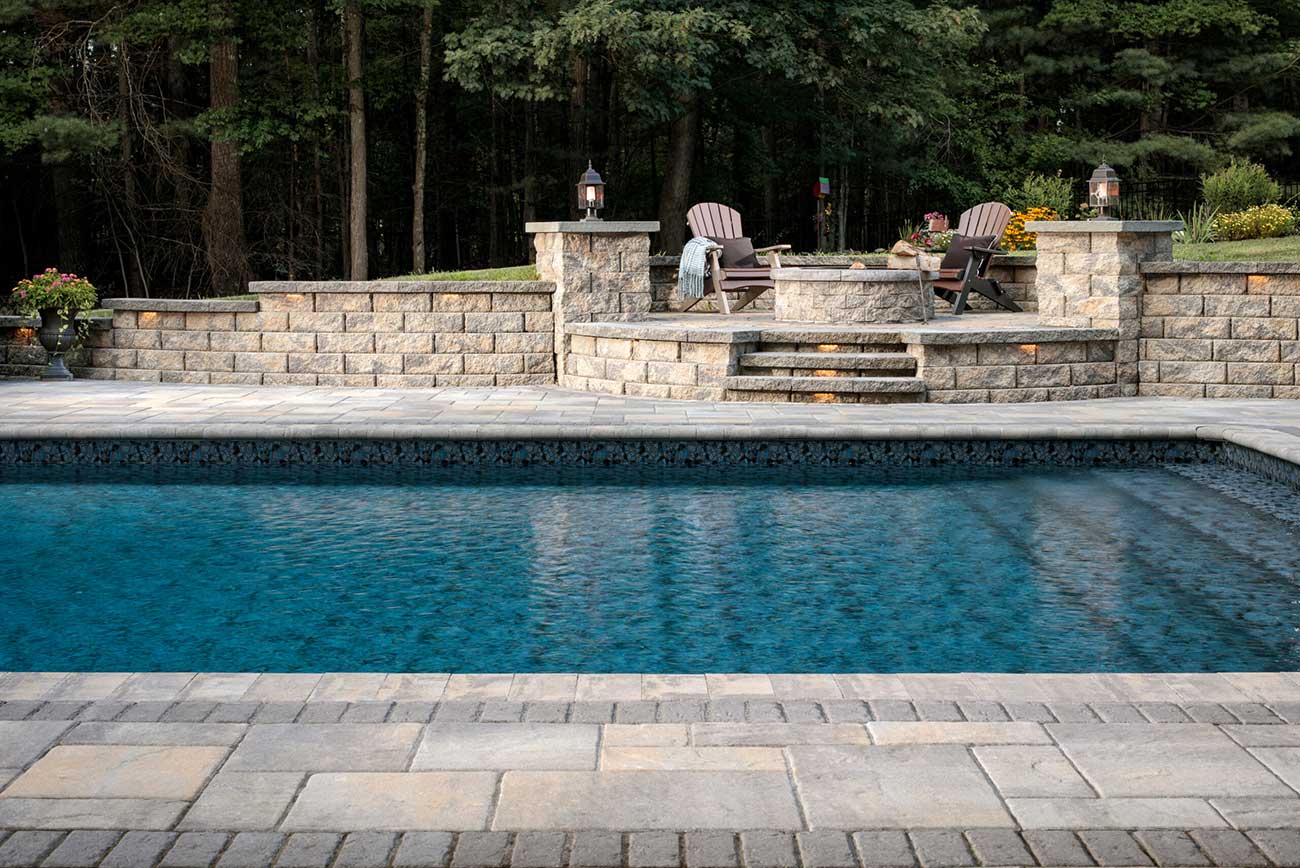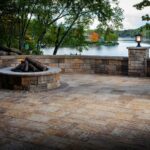Concrete Pavers vs Flagstone: Comparing Costs & Benefits
Flagstone is a naturally-occurring sedimentary rock, commonly excavated and cut to create individual concrete pavers and steps. They’re most commonly found in residential areas as they may not stand up to commercial use. The term flagstone is used to refer to several types of stone, primarily: Sandstone, Slate, Bluestone, Quartzite, and Limestone.

On the other hand, a concrete paver is made of colorful and versatile concrete, molded in an environmentally-controlled setting into thick stone-looking concrete pavers. They come in a wide variety of colors, shapes, sizes, textures, and designs. Concrete pavers can transform a residential or commercial property into a work of art. Concrete pavers also come in types defined by their appearance and function.
- Old World Pavers – Concrete pavers that mimic “European” streets, alleyways, and walkways found in cities like Seville, Spain; Prague, Czech Republic; Rome, and parts of London.
- Rustic Pavers – Stone-like texture and look with a rural appeal
- Grass In Between Pavers – A very eco-friendly paver that allows grass or flowers to grow between stones and water to pass through.
- Permeable pavers – Concrete pavers that maximize the passage of rain water through the surface to enter ground water, reducing toxic run-off and refilling our precious California water aquifers.

For full-disclosure, we specialize in concrete pavers. But we love paver patios, pool decks, and driveways so much that we want every customer to 100% feel they made the happiest choice for their outdoor space. Yes, flagstone will be better for some projects. There, we said it. Here’s the information to decide if concrete pavers or flagstone is right for you.
Visual Appeal Comparison
Both concrete pavers and flagstone have tremendous visual appeal. One of the great things about concrete is that when it’s still wet, you can mold it to look like real, natural stone. It’s hard to tell the difference. Both will make your neighbors, inlaws, and guests envious of your beautiful outdoor space.
With that said, concrete pavers can be customized in color, texture, etc. to perfectly design your space. Conversely, you can select flagstones that have a certain color, texture, shape, etc. But you are limited to what you can find, and how many you can find with certain qualities when acquiring stones for your project.
Of course, many people love the unpredictable variation and organic nature of flagstone, so your personal preferences come into play here.
Construction Requirements
Preparation for laying flagstone and concrete pavers is similar. However, there are some differences.
- Flagstones vary in thickness, even across one stone, so leveling the ground for the stone is stone specific. Concrete pavers are uniform thickness.
- Flagstone must be excavated from a quarry in slabs while concrete pavers are constructed in a factory from the raw minerals and rock particles that make natural rock. Concrete pavers are upcycling, taking rock fragments and minerals that could not themselves be stones and turning them into a durable paved surface.
- You can lay flagstones out separately and allow grass to grow between them, as you might with garden stepping stones. But flagstones are typically set into a concrete or mortar base layer and joints between stones. Because the flagstone is a natural stone, it doesn’t necessarily “fit together” seamlessly with other stones. Thus, you need mortar joints if you want a solid surface.
- Alternatively, the base layer for concrete pavers is typically gravel or sand. Because concrete paving stone manufacturers can make uniformly shaped interlocking stones, having this flexible base does not reduce their durability, stability, or levelness.
Maintenance Comparison
- In 2022, the national average for installing flagstone is $21.57 – $27.85 per square foot, which includes the cost of stones. But it could be more with premium stone selection. Alternatively, you can get quality concrete pavers installation for $18.96 – $24.91 per square foot, also including the stones.
- When it comes to maintenance, you can hose off or pressure wash both surfaces to remove accumulated debris and return the surface to its original sheen. You can also apply a sealant to both every 2-3 years, which costs around $.75-$1 per square foot. You should avoid allowing water to sit on the surface for long periods. Proper installation should prevent this.
- The cost to repair a flagstone patio can range from $5 – $25 per square foot, depending on the type of stone used. Repairing flagstone is more involved than concrete pavers because flagstones are often larger. You’ll also need to source a replacement stone of similar size, shape. You must repair the mortar joints. And you need to avoid damaging nearby stones. Each of these add to the cost.
- On the other hand, paver repair runs between $7-$30 per square foot. That sounds like more. But because pavers are smaller and damage is usually isolated to fewer pavers, your total repair bill is likely to be lower with concrete pavers.
Durability Comparison
Both flagstone and concrete pavers can last up to 50 years, sometimes longer. However, with flagstone, you will likely need to repair the mortar joints as weather can crack them and shift the levelness of the stone surface. Since concrete pavers are not set in concrete or mortar, you would only need to replace the broken concrete paving stone.
Best Applications for Flagstone
- Flagstone works well for patios and driveways. For commercial use and driveways, you should opt for larger, thicker slabs. It’s better for smaller projects since it’s harder to work with vs. concrete pavers. Of course, you can use pavers for these projects as well.
- Concrete pavers would be better for pool decks, unshaded gardens, or children’s play areas because flagstone gets very hot and will burn hands, feet, and plants within seconds.



